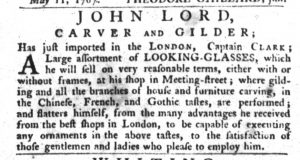What was advertised in a colonial American newspaper 250 years ago today?

“Gilding and all the branches of house and furniture carving.”
John Lord earned his living as a carver and gilder, but he also sold imported looking glasses, “either with or without frames, at his shop in Meeting-street” in Charleston. He likely constructed, carved, and gilded some of those frames in his own shop, replicating styles currently popular in London.
By his own account, Lord was skilled at his craft. He was capable of “gilding and all the branches of house and furniture carving, in the Chinese, French, and Gothic tastes.” In the same way that shopkeepers presented potential customers with an array of choices, Lord also catered to potential clients’ desire to express themselves through the types of ornamentation they selected for their furniture and homes. His invocation of “Chinese, French, and Gothic tastes” also echoed styles for exotic housewares, including decorative arts and imported porcelain tea sets and dishes, popular among eighteenth-century consumers who participated in increasingly global circuits of trade. Potential customers who already possessed imported Chinese porcelain, for instance, could commission looking glass frames or tables or sideboards with similar or matching elements to achieve a sense of cohesion and style.
In contrast to many other artisans who advertised in colonial newspapers, Lord did not indicate his origins. See, for example, the notice placed by “WHITING, SADLER, FROM LONDON,” that appeared immediately below Lord’s advertisement. Still, the carver and gilder asserted a connection to cosmopolitan center of the empire, reporting that because of “the many advantages he received from the best shops in London” that he was “capable of executing any ornaments in the above tastes, to the satisfaction of those gentlemen and ladies who please to employ him.” Lord suggested that he completed an apprenticeship in London or that he had worked alongside skilled artisans in notable workshops before migrating across the Atlantic. He had not learned his trade in the colonies; instead, he benefited from the cachet accrued by hinting that he had superior training compared to his provincial competitors. Closer connections to workshops in London could also mean that he developed better understandings of current fashions.
Charleston was one of the largest cities in Britain’s North American colonies, yet its residents still looked to London as they participated in consumer culture, adopted new fashions, and decorated their homes. In that context, John Lord took advantage of his previous experience working in “the best shops in London” to market his services as a carver and gilder.
